




Fire Extinguisher: An Introduction
Fire is one of the most powerful natural phenomena we use in our day-to-day life to perform various activities. This includes cooking, lighting, and a variety of other activities. All this takes place due to the controlled production of fire. Fire is a blessing for us and can be dangerous in a matter of seconds if not in a controlled way. For example, you have heard about forest fires and house fires, which have caused enormous damage. In these situations, we usually call the fire department to keep an eye on the fires. A fire extinguisher is used by fire wardens to extinguish a fire.
According to the principle of the fire triangle, to produce fire, three elements are required to be present. They are fuel (something that can burn), a source of heat (that can ignite the fuel) and air (for a constant supply of oxygen).
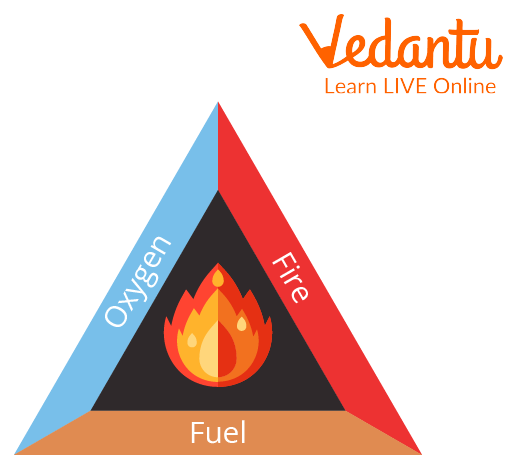
Fire Triangle
What is a Fire Extinguisher?
Fire extinguishers are external fire safety systems that are useful for extinguishing or controlling minor fires, often in emergencies. It is not intended for use in an uncontrollable fire, such as when the fire has reached the ceilings, endangering the client's safety (e.g., no evacuation route, smoke, explosive hazard, etc.) or otherwise requiring the capabilities of a fire service. A fire extinguisher normally consists of a portable cylinder pressure vessel carrying an agent discharging to suppress the fire.
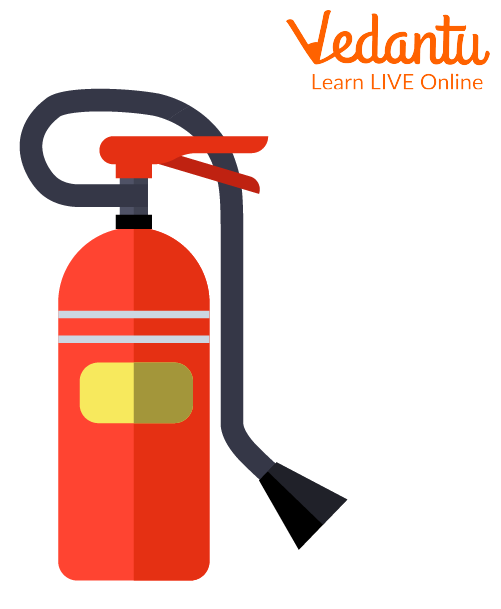
Fire Extinguisher
Classification of Fire
There are five categories of fires:
Class A Fire: Class A fires are fires caused by combustible materials, including paper, fabrics, timber and other flammable solids.
Class B Fire: Class B fires are fires caused by flammable liquids, such as paint, turpentine and gasoline, to name a few.
Class C Fire: Class C fires are fires caused by flammable gases, including methane, butane or hydrogen.
Class D Fire: Class D fires are fires caused by combustible metals, including potassium or magnesium.
Class K Fire: The burning of grease or oil from the cooking process falls under this category.
Types of Fire Extinguishers
Foam Extinguishers
Foam fire extinguishers are the most common form of fire extinguishers and they are useful for class B fires.
Water Extinguishers
They operate in the same manner as foam extinguishers. Water extinguishers are also used for fires caused by a variety of organic materials, including wood, cardboard, and paper.
Dry Powder Extinguishers
A dry powder extinguisher is a very versatile fire extinguisher choice since it can be used on almost all types of fires. They may also be useful in fires involving electrical apparatus.
Wet Chemical Extinguishers
Wet chemical extinguishers are used in Class K fires, including cooking oils and grease. They're also helpful in class A fires, but a foam or water extinguisher is more commonly used for this fire hazard.
Carbon Dioxide (CO2) Extinguishers
Carbon dioxide (CO2) fire extinguishers are mainly used for the risk of electric fire and are generally the main type of extinguisher in the server room. CO2 extinguishers suppress fires by displacing oxygen, which the fire must burn.
Fire Extinguisher Sign
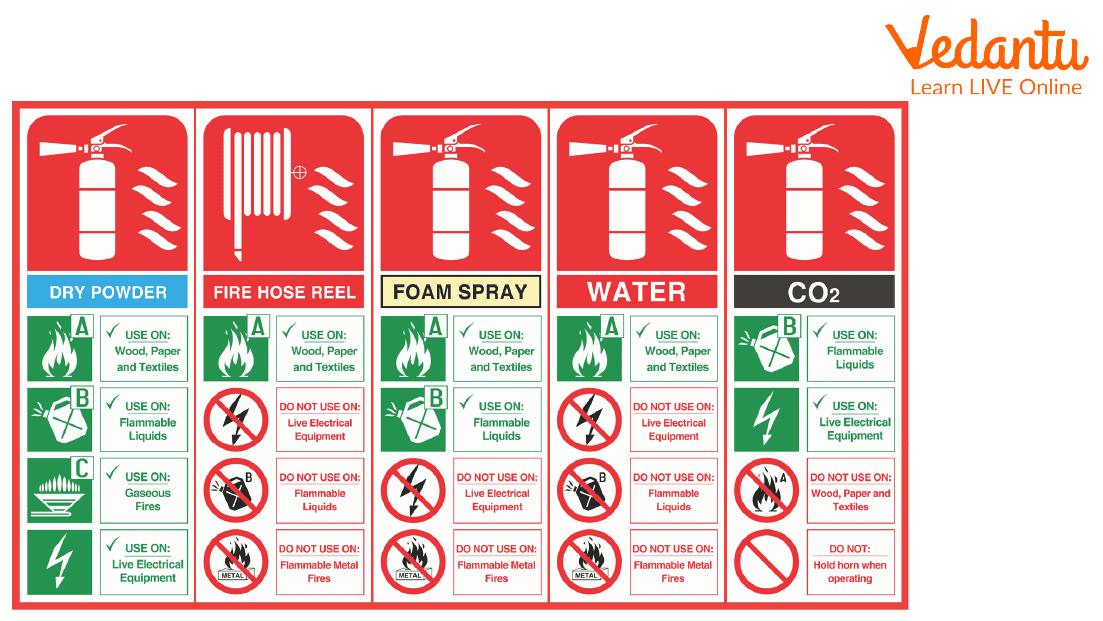
Fire Extinguisher Sign
How to Use a Fire Extinguisher?
Most extinguishers work with the following P.A.S.S. technology:
PULL - Pull the pin. That will also break the tamping seal.
AIM - Aim low, pointing the fire extinguisher nozzle (or its horn or pipe) at the base of the fire.
SQUEEZE - Press the handle to release the fire extinguisher.
SWEEP - Sweep from one side to the other at the base of the fire until it looks like it's out. Watch the area. If the fire starts again repeat steps 2 - 4.
Working of Water Fire Extinguisher
When firefighters begin spraying water on the areas where the fire took place, the water cools the temperature of the fire. The fuel ignition temperature drops because of continuous water spraying, so the fuel can't burn anymore, so it keeps the fire from spreading. Water vapours block the oxygen supply at the fuel surface, thereby reducing the oxygen supply at the fuel surface.
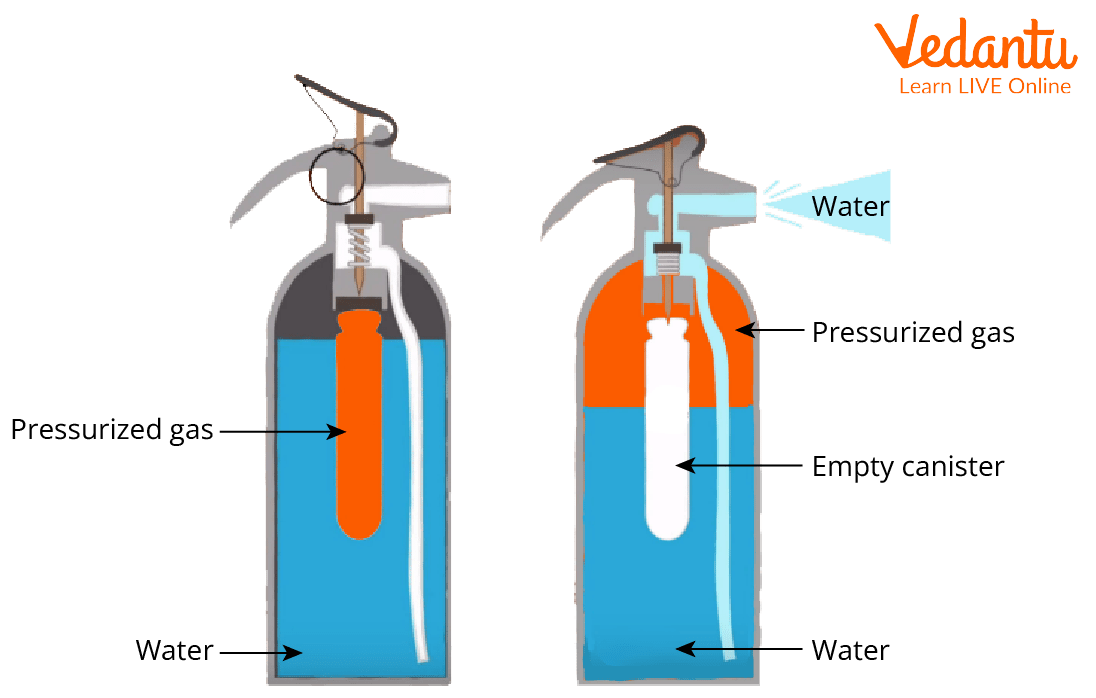
Water Fire Extinguisher
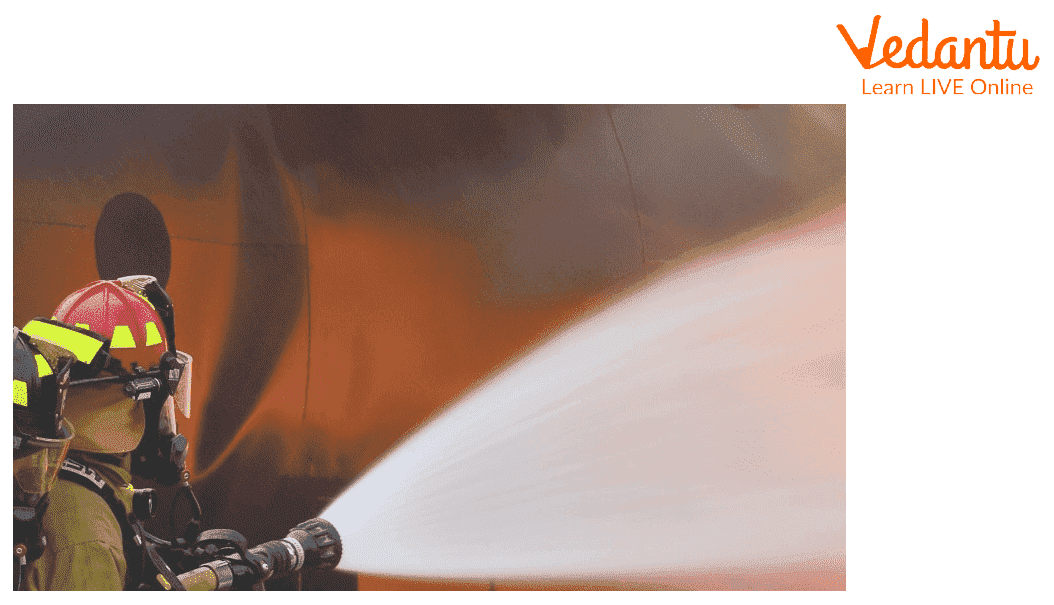
A Firefighter
Conclusion
Fire extinguishers are used to suppress fire. There are 5 types of fires and different types of fire extinguishers are used to suppress these different types of fires. Positive advancements in industrial fire safety have been brought about by a greater awareness of fire risk elements. The expense of industrial fire threats has dropped thanks to advances in loss control and fire prevention engineering.
FAQs on Fire Extinguisher - The Life Saviour
1. What are multipurpose extinguishers?
The majority of portable extinguishers are approved for use with several types of fire. For instance, a BC-rated extinguisher can be used to put out fires involving electrical equipment that is electrified and flammable substances. For use with fires involving common combustibles, flammable liquids, and powered electrical equipment, an extinguisher with an ABC rating is appropriate. A symbol for each kind of danger should be included on any extinguisher that is approved for use with multiple hazards. These are called multipurpose extinguishers.
2. What are Class K fires?
Grease made from animals or plants, as well as flammable cooking liquids like cooking oil, are the main sources of fuel for Class K fires. These liquids become volatile and quickly ignite when heated to high temperatures. They also spread quickly as a result of their great flammability.
Commercial kitchens, including restaurants but also corporate cafeterias, food trucks, bakeries, and other food enterprises, are where Class K fires are most likely to occur. Class K fire extinguishers should be provided for these establishments as part of a comprehensive fire safety strategy.
3. Give the conditions under which combustion occurs. Why is it harder to burn certain combustible substances than other ones?
Some combustible materials are more challenging to burn than others because they ignite at various temperatures. Some compounds burn more readily than others because they have lower ignition temperatures. When determining a substance's combustibility, the temperature at which it ignites is crucial.
To burn the fuel the following points are necessary:
The existence of something combustible, like coal, natural gas, or wood.
The availability of air to supply oxygen.
The fuel temperature may be raised above its ignition point using heat.




































